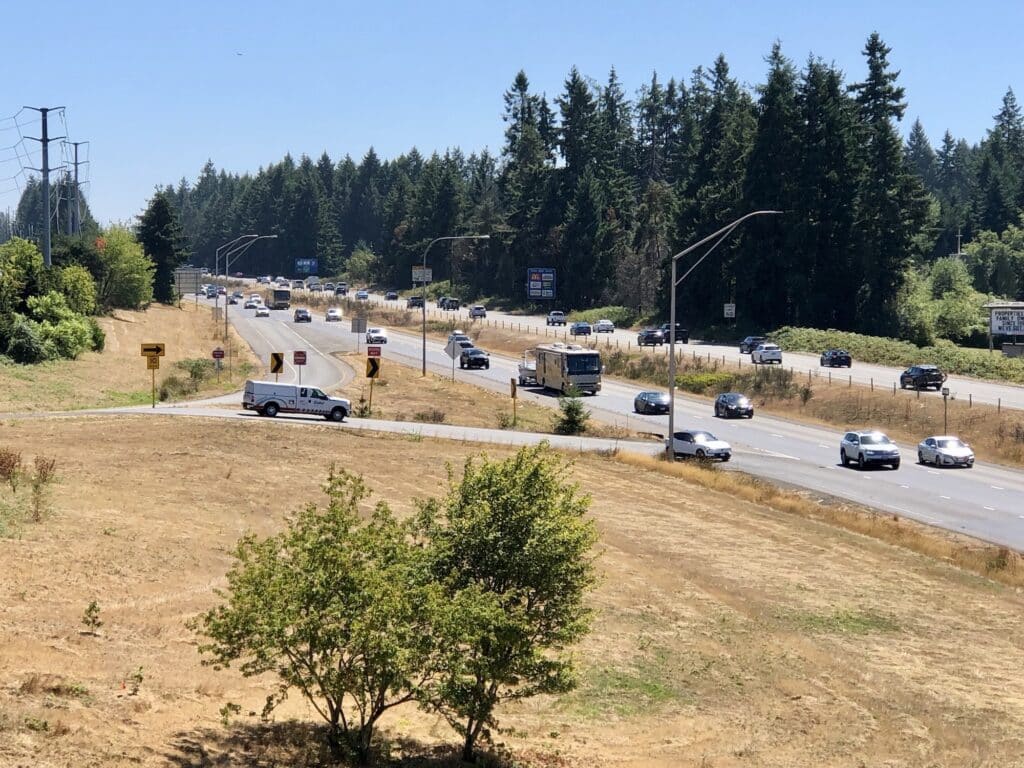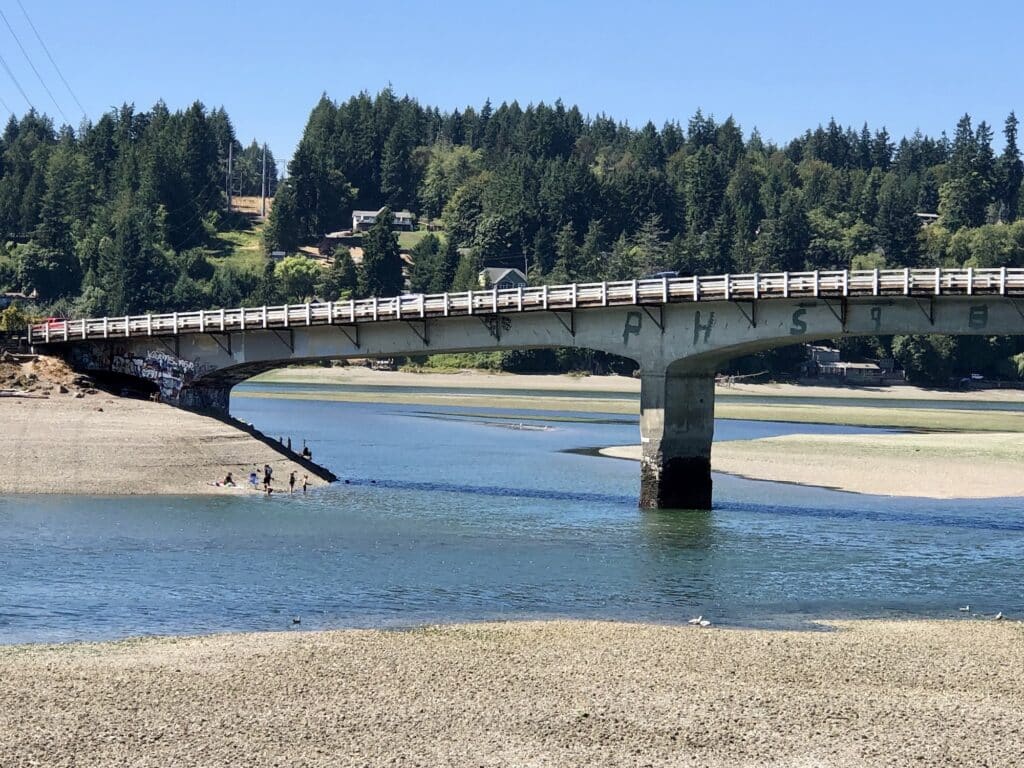Community Government Transportation
Senate candidates reflect on local highway issues
State Senate candidates Deb Krishadasan and Michelle Caldier remarked about the state’s limited progress on two of the area’s thorniest traffic issues — Wollochet Drive on-ramps and Purdy congestion.
From 2011 to 2021, 287 collisions occurred at the busy Wollochet interchange, according to state Department of Transportation (WSDOT) records. Approaching Highway 16, vehicles must travel through loop on-ramps at 10 mph before merging into the mainline. Drivers navigate the tight circle while looking for a gap in traffic and getting up to speed. The merge lane is short, resulting in many not reaching the 60 mph limit before entering the traffic stream.
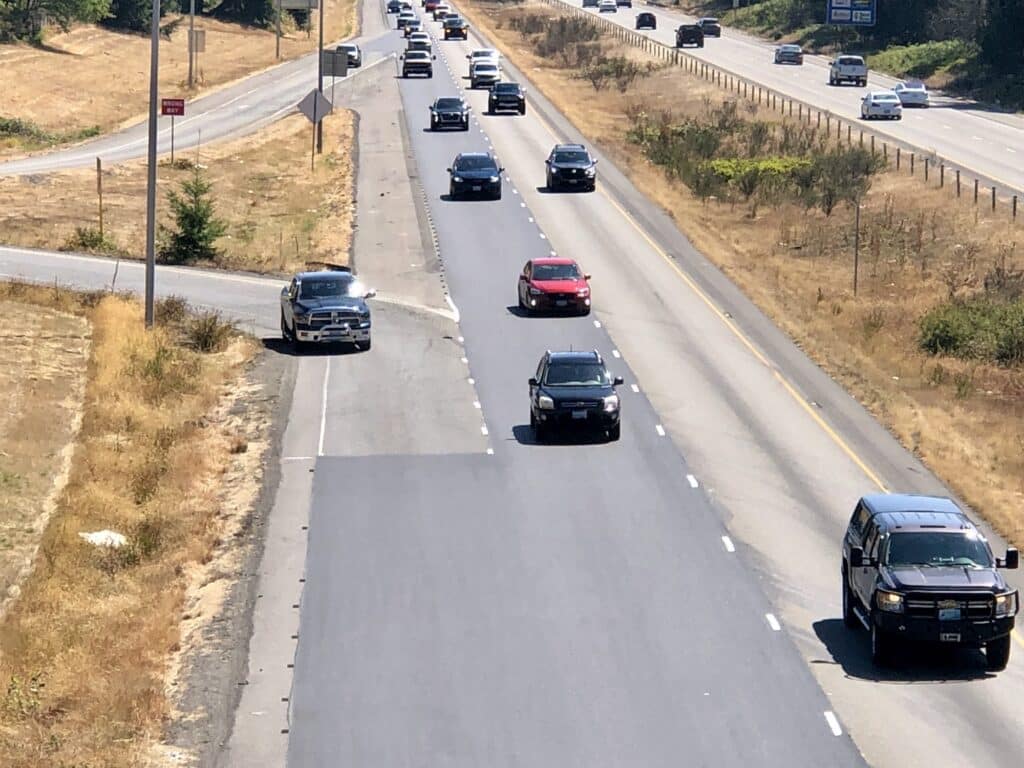
A truck enters westbound Highway 16 from Wollochet Drive. A 2018 WSDOT study recommended extending the acceleration lanes within 10 years. Photo by Ed Friedrich
In Purdy, vehicles get slowed at a traffic signal and skinny, 88-year-old old bridge, backing up traffic to Highway 16.
Both problems were topics of WSDOT’s 2018 Highway 16 congestion study that recommended short-term (within 5 years), mid-term (10 years) and long-term (20 years) fixes. Few have been achieved.
When asked if WSDOT has any plans now for the Purdy vicinity, spokeswoman Angela Cochran wrote: “We don’t have funding for any projects related to the Purdy bridge at this time.”
Krishnadasan keeps peers informed of local needs
Krishnadasan, D-Gig Harbor, said she’s keeping the projects on lawmakers’ radar.
“I’m on the Transportation Committee and working with Chairman (Marko) Liias so I can continue to make him aware of the Purdy bridge and Wollochet interchange, projects that might not be high on the priority list at this point but I have to make sure they continue to be talked about,” said Krishnadasan, who was appointed to Emily Randall’s seat in December after Randall was elected to Congress.
“They’re not going to be solved overnight, but you must keep them on the radar and fight to make progress both short- and long-term. It’s my job to be a strong advocate for local input and collaborative planning to keep moving efficiently and safely for our district.”
The state should return its transportation focus to adding capacity and alleviating congestion, said Caldier, R-Gig Harbor. Democrats, who have held a legislative majority since 2012 and the governorship for 30 years, swung emphasis away from private vehicles.
Caldier wants focus returned to capacity
“The majority of funding in our transportation budget does not prioritize fixing congestion problems,” said Caldier. “Since I’ve been in office (11 years), there’s been a switch to spending transportation dollars focused on multimodal — bus, light rail, pedestrian walkways, bike paths — and fish culverts.
“The philosophy with the majority party is if you build more pedestrian walkways and bike paths, people will stop driving, and bike or walk to work. There is a view that people who are driving are contributing to climate change, and the solution to climate change is to get people to stop driving. That is not the reality for the average Washingtonian. As a result, we have serious congestion problems.”
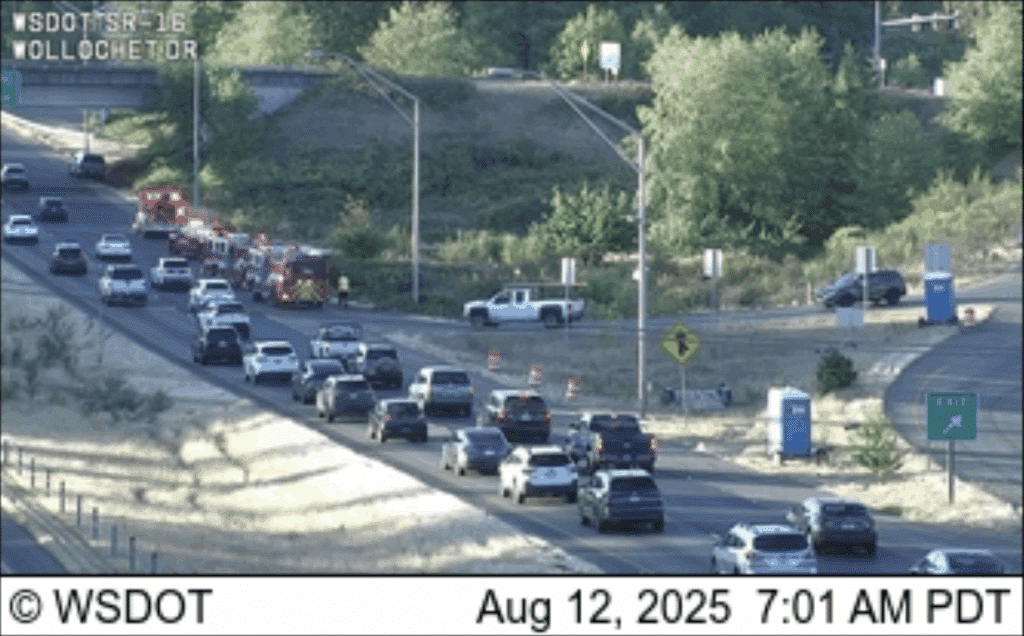
The most recent Wollochet Drive crash, from a WSDOT camera, was Tuesday morning, Aug. 12. This was merging onto eastbound Highway 16. WSDOT photo
Dennis Engel, WSDOT multimodal planning manager, said in an earlier story about the Wollochet on-ramps that the state has limited funds for expansion.
“What I’m hearing is that infrastructure money will be going toward preservation, fish passage and bridge preservation,” he said. “We don’t have enough funding to maintain the roads we have, let alone all the fish passages we have to do by 2030 and all the safety work we have programmed, so we’re not out looking or advocating for mobility-type projects.”
High taxes should result in better roads
Washington should have enough money, Caldier said. Its gas tax of 55.4 cents per gallon, including 6 cents that was added on July 1, ranks as the third-highest in the country, behind California and Pennsylvania. According to the 18th Amendment to the state constitution, money collected from gas taxes must be used for building and repairing roads and bridges, policing highways and paying off road construction bonds. It can’t go to public transit and bike or pedestrian projects.
“The taxes that citizens are paying are astronomical, one of the highest in the country,” Caldier said. “Our roads should be pristine. There should not be any issues, for the amount of money that we are getting. The sad part is that money is not being spent the way people want it to be spent. And the other sad part is news outlets are got giving the truth to the public, so the public doesn’t realize their money is not going to where it’s supposed to be going.”
The Legislature passed at least four transportation revenue packages since 2003 worth $43.8 billion, in addition to biennial transportation budgets. The 2025-27 budget is for $15.5 billion. All three 26th District lawmakers — Krishnadasan, Caldier and Rep. Adison Richards, D-Gig Harbor, voted against it. The 6-cent gas tax increase was too much for families already struggling with rising costs, and would disproportionately impact commuting workers, Krishnadasan said.
Near-term fixes coming soon
The $2.4 million Highway 16 congestion study recommended signal timing and turn pocket improvements on each end of the Wollochet Drive overpass as near-term fixes. On the east end, Gig Harbor will build a right-turn lane to access the westbound on-ramp to Highway 16. On the east end, a right-turn lane will be added to the eastbound off-ramp from Highway 16. Traffic signals will be synchronized from Hunt Street to Kimball Drive.
Each project is expected to cost $990,000 and begin construction in summer 2026. The Legislature allocated $840,000 for each in the 2023-25 transportation budget and reallocated the funds in the 2025-27 budget.
“There may be things that we can do in the interim to help,” Krishnadasan said of Wollochet troubles, “such as the $1.68 million secured (originally) by Emily Randall that I fought to keep in the 2025-27 budget. It might not be a long-term solution, but what shorter-term, interim projects can be done to help with safety and traffic flow?
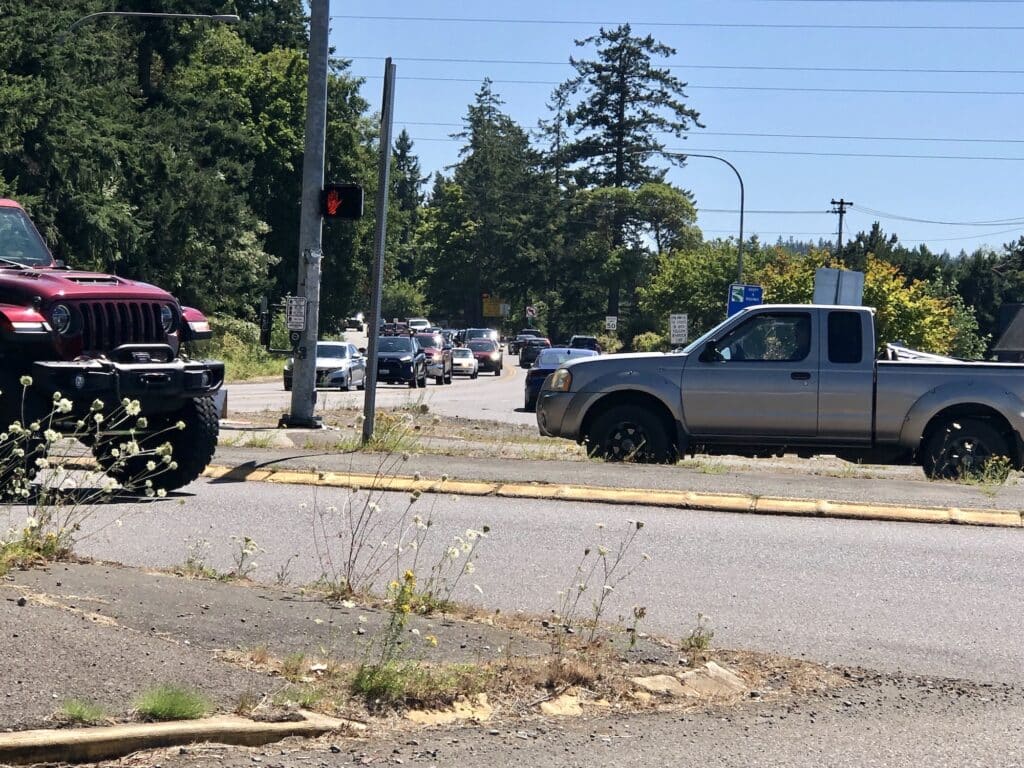
Traffic often backs up more than a mile from this signal in Purdy to Highway 16. Photo by Ed Friedrich
The study prescribed extending acceleration lane lengths in the mid-term (10 years). Removing the loop ramps and replacing them with a full diamond interchange, possibly including a widened overpass, was recommended as a long-term (20 years) solution, along with a Hunt Street crossing over Highway 16 to siphon traffic from crowded Wollochet and Olympic Drive interchanges.
Purdy won’t be bypassed any time soon
WSDOT began a $2.5 million Highway 302 corridor study in 2007. It proposed four options to the roadway between Highway 16 and where it forks with the Key Peninsula Highway. Two choices that didn’t cross Burley Lagoon were estimated in 2009 to cost $56 million. Those that did bridge the water were $238 million and $272 million. The study wasn’t fully funded and was put on hold in 2013 before completion and without determining a final alternative.
With a corridor bypassing Purdy indefinitely out of the picture, the Highway 16 congestion study recommended improvements within Purdy. In the near term, it suggested configuring the westbound off-ramp from Highway 16 to the Highway 302 spur (Purdy Drive) to allow shoulder driving and keep vehicles from backing onto the highway. Drivers can now use the shoulder from 2 p.m. to 7 p.m. on weekdays.
It also recommended lengthening the left-turn lane at the Purdy intersection, and completing the Environmental Impact Statement for a new Highway 302 corridor that includes a preferred alternative.
In the mid-term, the study called for installing a traffic signal or roundabout at the Highway 302 spur-Goodnough Drive intersection. A long-term fix is to add a lane to the northbound spur so traffic going straight doesn’t get stuck behind vehicles turning left to the bridge.
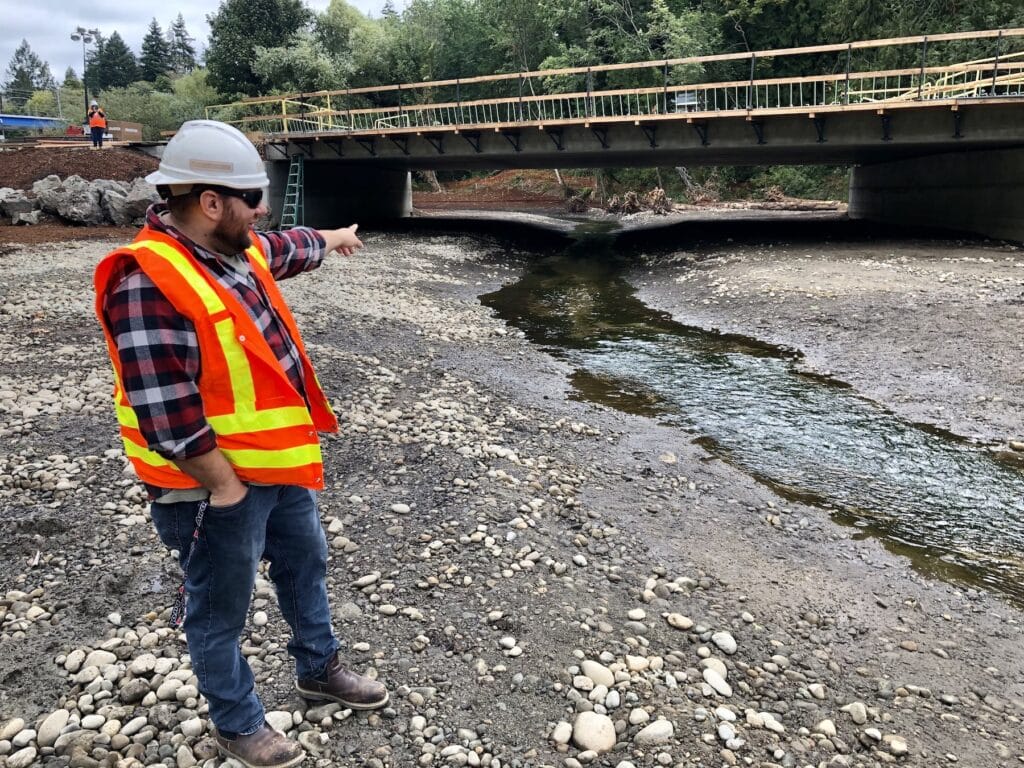
Project engineer Justin Janke describes a bridge that replaced a fish-blocking culvert in Purdy. Photo by Ed Friedrich
Culvert replacements eat into road dollars
One 26th District project that is moving forward is in Gorst. WSDOT received $74.3 million in the Move Ahead Washington funding package for design and right-of-way to build an additional lane on Highway 3 in each direction from Gorst to Bremerton, elevate the roadway through Gorst, replace the Navy’s railroad crossing and complete associated fish passage work. As part of this project, the state will update the 2018 Highway 16 congestion study.
Fish passage projects are taking a big bite out of transportation dollars. In 2013, a federal judge issued a permanent injunction requiring the state to repair by 2030 more than 600 state-owned fish-blocking culverts that violate treaty promises. The state estimates the cost will be at least $8.8 billion. As of June 2025, WSDOT had completed 176 barrier corrections.
Much of the work has occurred in the 26th District. The state replaced culverts with bridges at Minter and Little Minter creeks ($16.2 million) on Highway 302, and Purdy Creek ($41.6 million) and Anderson Creek north of Gorst ($9.5 million) on Highway 16. A $56.7 million project is wrapping up on Blackjack Creek on Highway 16 near Sedgwick Road and Salmonberry Creek on Sedgwick itself.
A $94 million job is planned for Burley Creek on Highway 16 near Mullenix Road. Also in the works is replacing culverts from Gorst, Kabelac and Olney creeks and Gorst Creek and Ross Creek tributaries. The work, plus installation of a roundabout at the Highway 3, Highway 16 and West Sam Christopherson Avenue intersection, is estimated at $192.6 million.

